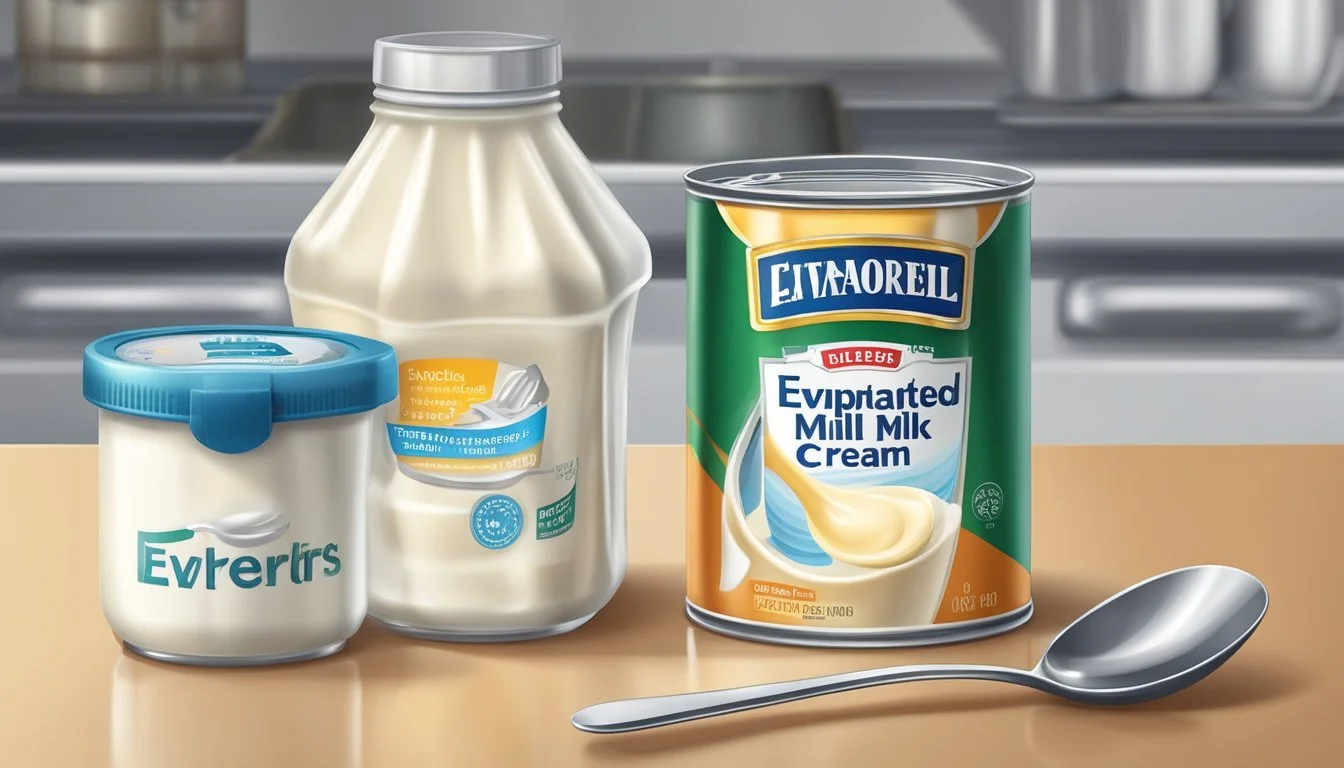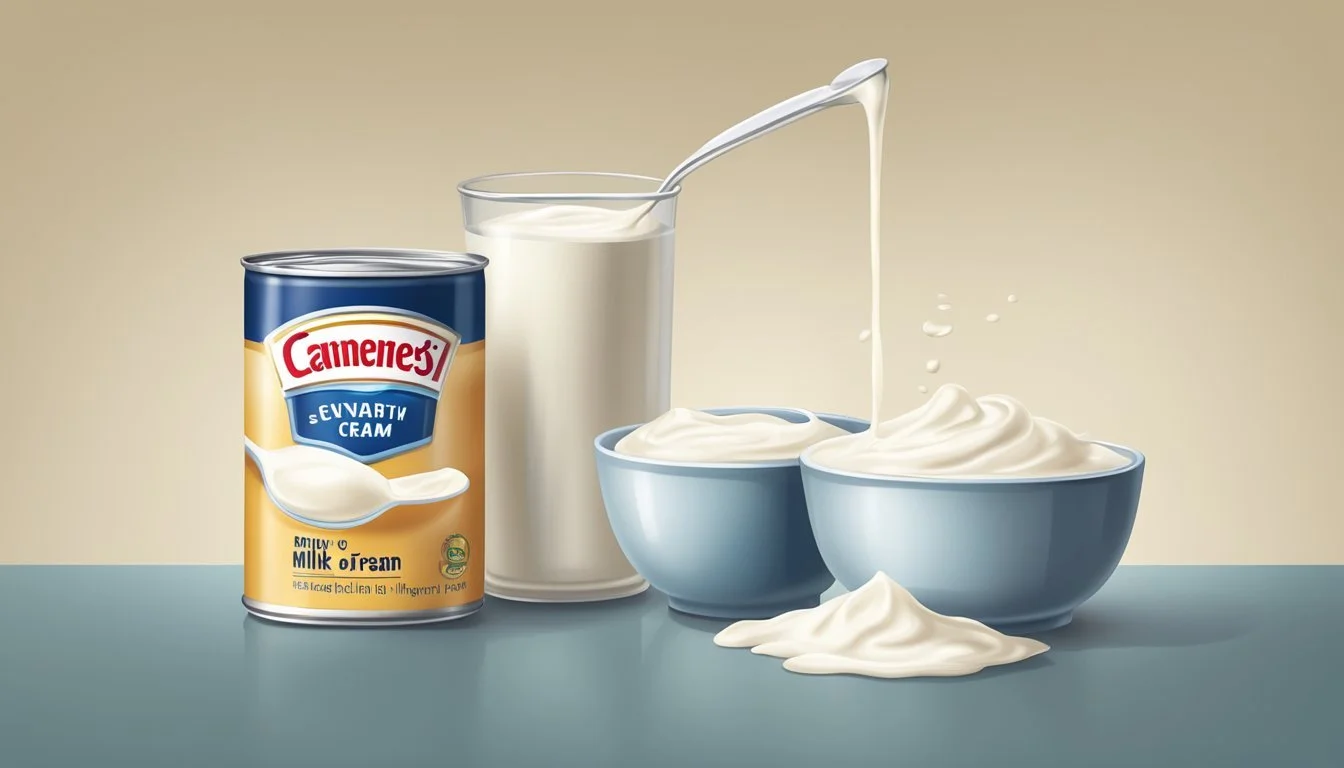How to Substitute Evaporated Milk for Heavy Cream
A Simple Guide
Substituting evaporated milk for heavy cream (how long does cream last?) is a common practice in cooking and baking, offering a lower-fat and calorie alternative while still providing the desired creamy texture and richness. Evaporated milk, with 60 percent of its water content removed, has a concentrated flavor and consistency that can mimic the properties of heavy cream in many recipes. Whether it's for dietary restrictions, health considerations, or simply convenience, understanding how to effectively use evaporated milk as a heavy cream substitute can expand culinary possibilities and help maintain the integrity of dishes.
When considering the substitution, it's important to note that while evaporated milk can often stand in for heavy cream, it does possess a lighter fat content and a subtly different taste. In baked goods or liquid-based recipes such as soups and sauces, evaporated milk typically performs well as a substitute. However, for recipes that require the full-bodied richness of heavy cream, like those requiring whipped cream, the results with evaporated milk may differ. It's crucial to adjust expectations and sometimes recipe quantities to achieve a desirable outcome when making this substitution.
Understanding Dairy and Cream Substitutes
When substituting dairy products in recipes, understanding the properties and potential replacements for heavy cream is essential. Alternatives can cater to different dietary needs and cooking requirements while aiming to achieve a similar texture or flavor.
Comparing Heavy Cream and Evaporated Milk
Heavy cream is a rich dairy product containing about 36-40% fat, providing a thick consistency and richness to dishes. It can be whipped and is often used in desserts and sauces. In contrast, evaporated milk has had about 60% of its water content removed, resulting in a concentrated milk that is lower in fat than heavy cream, typically containing around 8% of fat.
Substitutes for Heavy Cream
When replacing heavy cream, one may consider several alternatives based on the desired outcome:
For Baking and Cooking:
Evaporated milk can be used in a 1:1 ratio for heavy cream to maintain a creamy texture with less fat.
A mixture of three parts milk to one part heavy cream can also mimic the texture without being as heavy.
Half-and-half, a combination of milk and cream averaging about 10-18% fat, is another substitute that can be used directly in equal amounts.
For Dairy-Free or Vegan Options:
Coconut cream, with its higher fat content and the ability to be whipped, is an excellent dairy-free alternative.
Other plant-based creams derived from nuts or soy can be effective replacements but might alter the flavor profile.
Potential Reasons for Substituting
Individuals may seek substitutes for heavy cream due to a range of reasons, including:
Health considerations: Lower saturated fat intake by opting for alternatives such as evaporated milk or half-and-half.
Dietary restrictions: Dairy-free and vegan options are vital for those adhering to specific diet plans or with lactose intolerance.
Availability: Occasionally, a substitute might be employed simply because heavy cream is not on hand.
Substitution Basics
When substituting evaporated milk for heavy cream, it's essential to understand the differing properties of each to achieve the desired outcome in recipes.
Understanding Fat Content and Consistency
Evaporated Milk:
Fat Content: < 10%
Consistency: Thicker than milk, more fluid than heavy cream
Heavy Cream:
Fat Content: ~36-40%
Consistency: Thick, able to be whipped into stiff peaks
Evaporated milk and heavy cream differ significantly in fat content and consistency. Heavy cream's high fat content contributes to its ability to be whipped and its rich texture in recipes, whereas evaporated milk has a lower fat content and a more liquid consistency. They should recognize that while both can impart creaminess, evaporated milk will not thicken a dish in the same way heavy cream does.
Adjusting for Taste and Texture
To mitigate these differences:
Flavor: One can add a pat of butter to evaporated milk to mimic the richer flavor of heavy cream.
Texture: For thickening, an appropriate thickening agent like flour or cornstarch may be necessary.
Changes in taste and texture must be addressed when using evaporated milk as a substitute. Although it can adequately replace liquid heavy cream in recipes like soups and sauces, its lower fat content means it won't provide the same taste or ability to thicken. To approximate the creamy mouthfeel of heavy cream, additional adjustments are needed—adding a small amount of butter can enhance the richness, while agents like flour or cornstarch aid in reaching the desired texture.
Culinary Applications
Evaporated milk serves as a versatile ingredient in cooking and baking. It offers a creamy texture to various dishes while also providing a lower-fat alternative to heavy cream.
Using Evaporated Milk in Sauces and Soups
In creamy sauces (What wine goes well with creamy sauces?) and soups, evaporated milk can easily take the place of heavy cream. Chefs often use it in dishes like Alfredo sauce or creamy soups to reduce the overall fat without sacrificing the rich consistency. The key to success is to add evaporated milk towards the end of the cooking process to prevent curdling.
Alfredo Sauce: Substitute in a 1:1 ratio, heating gently.
Creamy Soups: Stir in evaporated milk in the final stages of simmering.
Enhancing Desserts and Baked Goods
For desserts and baked goods, evaporated milk can provide the moisture and richness typically contributed by heavy cream. When making desserts, such as custards (how long do custards last?) or ice creams, it's often combined with sweetened condensed milk to achieve the desired sweetness and texture.
Yogurt Pound Cake: Replace heavy cream with evaporated milk to maintain moisture.
Custards and Ice Creams: Blend with sweetened condensed milk for sweetness and creamy consistency.
Bakers take advantage of evaporated milk's lower water content to create tender textures in cakes and pastries. When a recipe calls for heavy cream, using evaporated milk can help lighten the dish while still providing that creamy, indulgent mouthfeel.
Practical Substitution Tips
When substituting evaporated milk for heavy cream, it's essential to acquaint oneself with the proper ratios and understand the various alternative options to ensure the desired creamy texture and flavor profile are achieved in recipes.
Measuring and Mixing for Substitution
To substitute evaporated milk for heavy cream, a simple rule of thumb is as follows:
Combine three parts whole milk to one part heavy cream to replicate the richness and creaminess of heavy cream.
Alternatively, half-and-half can be used straight in a 1:1 ratio for many recipes, from sauces to baked goods.
This mixture should then be blended well to ensure even consistency. One should also note that this substitution may slightly alter the taste and overall richness, as evaporated milk lacks the higher fat content that heavy cream possesses.
Non-Dairy and Vegan Alternatives
For those seeking non-dairy or vegan substitutes:
Coconut cream stands as a versatile option. It is naturally creamier and can even be whipped, making it suitable for desserts.
Plant-based milks can be used combined with a thickening agent to add body and mimic the consistency of heavy cream.
It's important to remember that plant-based alternatives may introduce distinct flavors and may not always behave identically to dairy when heated or mixed. Using these alternatives is a cost-effective and allergy-friendly choice, but one should be prepared for slightly different results in terms of taste and texture.
Nutritional Considerations
When substituting evaporated milk for heavy cream, it is essential to evaluate the nutritional impact of the switch, particularly concerning calories and fat content, as well as how the substitution aligns with individual dietary needs and health goals.
Caloric and Fat Comparisons
Evaporated Milk
Calories per 1 cup: Approximately 340
Total Fat: Around 20 grams
Heavy Cream
Calories per 1 cup: Approximately 821
Total Fat: Approximately 88 grams
Substituting evaporated milk for heavy cream results in a significant reduction in both caloric and fat content. It is a practical choice for those looking to decrease their calorie intake or limit fat consumption.
Dietary Needs and Health Aspects
Lactose Content: Both evaporated milk and heavy cream contain lactose, making neither ideal for a lactose-free diet. However, the lactose content is higher in evaporated milk due to the concentration process.
Dietary Needs: Individuals following a low-fat or reduced-calorie diet may benefit from using evaporated milk as a substitute for heavy cream. It provides a relatively lighter alternative while still contributing to the creamy texture and richness desired in many recipes.
Health Considerations: The lower fat content in evaporated milk may make it a more suitable option for those managing heart health or looking to maintain a balanced diet. It should be noted, however, that both products are dairy-based and should be used in moderation within a well-rounded diet.
Alternative Substitutes for Heavy Cream
When one requires a substitute for heavy cream, choices span across both dairy-based and plant-based options. These alternatives can match the cream's richness and texture for various culinary applications.
Other Dairy-Based Options
Half-and-Half: Lighter than heavy cream, half-and-half combines equal parts of whole milk and light cream, suitable for soups and sauces.
Whole Milk and Butter: Combining 3/4 cup of whole milk with 1/4 cup of melted butter yields a close approximation to heavy cream's fat content, though it won't whip.
Cream Cheese: For cheesecakes and frostings, cream cheese can provide the dense, creamy texture that one would usually get from heavy cream.
Sour Cream: In dressings and baked goods, sour cream can replace heavy cream for a tangier flavor profile.
Mascarpone: This Italian cream cheese offers a luxurious and thick consistency, perfect for desserts and frostings.
Plant-Based and Non-Dairy Substitutes
Coconut Cream: A non-dairy delight, coconut cream can mimic heavy cream in desserts, and it's capable of being whipped.
Greek Yogurt: When thickness and tang are desirable, Greek yogurt serves as an excellent stand-in for heavy cream in dips and sauces.
Condensed Milk: While sweeter, condensed milk can stand in for heavy cream in certain baking recipes, although it lacks the same fat content.







